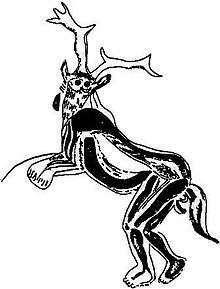Trois Frères

The Cave of the Trois-Frères is a cave in southwestern France famous for its cave paintings. It is located in Montesquieu-Avantès, in the Ariège département. The cave is named for the three sons of Comte Bégouen who discovered it in 1914. (In French: trois frères means "three brothers".) The drawings of the cave were made famous in the publications of the Abbé Henri Breuil. The cave art appears to date to approximately 13,000 BC.
One painting, known as "The Sorcerer", is as familiar as any art in the more famous cave of Lascaux.
Engravings featuring what appear to be several birds and a cave grasshopper were found on a fragment of bison bone at the junction of Trois-Frères with the Grotte d'Enlène. The grasshopper was portrayed with such fidelity that the insect's species has been determined.[1] It is thought to be the earliest known representation of an insect.[2]
A variety of engraved animals are found on the cave walls, including lions, owls, and bison. Of particular note is a horse overlaid with claviform (club-like) symbols,[3] and an apparently speared brown bear vomiting blood.[4]
Aside from the "Sorcerer", other human-like figures can be seen at Trois-Frères, such as the man-bison, and a character known as the "small sorcerer" who appears to be playing a nose-flute.[2] Also of interest is an etched representation of a 59 cm long phallus that follows the contours of the cave walls.[5]
Tuc d'Audoubert
The Trois-Freres cave is part of a single cave-complex formed by the Volp River. The complex is divided into three caves; the central Trois-Freres, Enlène to the east, and the Tuc d'Audoubert to the west.
The Tuc d'Audoubert was discovered by the three teenage brothers in 1912. The galleries are situated on three levels; the River Volp flows through the lowest, the middle contains decorated galleries known as the La Salle Nuptiale and La Galerie des Gravures, while the upper has further decoration in La Chatièr and Salle des Talons and finishes in the Salle des Bisons.[6]
The Salle des Bisons contains two masterfully modelled bison, which were sculpted in clay with a stone spatula-like tool and the artist's fingers. The pair are among the largest and finest surviving prehistoric sculptures.[7]
References
- ↑ Connell, Evan (2001). "Olduval & All That". The Aztec Treasure House. Washington, D.C.: Counterpoint. p. 37. ISBN 1-58243-162-0.
- 1 2 Bégouën H., 1929: À propos de l'idée de fécondité dans l'iconographie préhistorique, Bulletin de la Société préhistorique française, 26, 3, pp 197–199.
- ↑ Sieveking, A., 1979: Cave Artists (Ancient Peoples and Places)
- ↑ Breuil H., 1930: Un dessin de la grotte des Trois frères (Montesquieu-Avantès) Ariège, Comptes rendus des séances de l'Académie des Inscriptions et Belles-Lettres, 74e année, N. 3, 1930. pp. 261–264.
- ↑ Bégouën E., Bégouën M., 2013a: Découverte d'un grand phallus gravé magdalénien dans la grotte des Trois-Frères (Ariège), Bulletin de la Société Préhistorique Française, Tome 110, numéro 1, janvier-mars 2013, p. 127–129.
- ↑ Bégouën R., Clottes J., 1991: Portable and Wall Art in the Volp Caves, Montesquieu-Avantès (Ariège), Proceedings of the Prehistoric Society, 57, pp 65-79.
- ↑ Kleiner, Fred (2009). Gardner's Art through the Ages: The Western Perspective, Volume 1. p. 36. ISBN 0495573604.
External links
| Wikimedia Commons has media related to Category:Caves of Tuc d'Audoubert. |
Coordinates: 43°01′56″N 01°12′42″E / 43.03222°N 1.21167°E